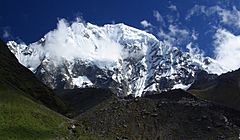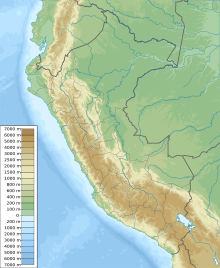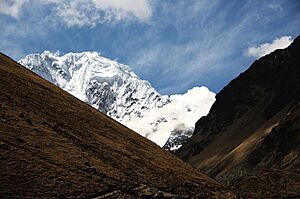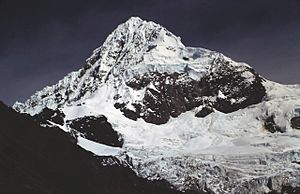Salcantay facts for kids
Quick facts for kids Salcantay |
|
|---|---|

View from the southwest.
|
|
| Highest point | |
| Elevation | 6,271 m (20,574 ft) or 6,264 m (20,551 ft) |
| Prominence | 2,540 metres (8,330 ft) |
| Listing | Ultra |
| Geography | |
| Location | Cusco Region, Peru |
| Parent range | Vilcabamba, Andes |
| Climbing | |
| First ascent | August 4, 1952, by Fred D. Ayres, David Michael Jr., W. V. Graham Matthews, George Irving Bell, Claude Kogan, M. Bernard Pierre |
| Easiest route | Northeast ridge: technical glacier/snow/ice climb (French grade AD) |
Salcantay, also called Salkantay or Sallqantay (in the Quechua language), is a very tall mountain in Peru. It is the highest peak in the Vilcabamba mountain range, which is part of the Andes mountains. You can find it in the Cusco Region, about 60 kilometers (37 miles) northwest of the city of Cusco. Salcantay is the 38th highest mountain in the Andes. It is also the 12th highest in Peru.
Because Salcantay is close to Machu Picchu, many people enjoy hiking around it. This hike is known as the Salkantay trek. It is a great way to see the area if the main Inca Trail is too busy.
Contents
The History of Salcantay Mountain
The name Salkantay comes from the Quechua word sallqa. This word means wild, untamed, or unbeatable. People have used this name since at least 1583. Because of this, the mountain's name is often translated as "Savage Mountain."
Just north of Salcantay is the famous ancient city of Machu Picchu. Machu Picchu is at the end of a ridge that comes down from Salcantay. The Inca people believed Salcantay was a very important god. They thought it controlled the weather and made the land fertile. This was especially true for the area west of Cuzco.
Climbing Salcantay Mountain
Salcantay is a huge and very steep mountain. It rises high above the low valleys to its north. These valleys lead to the Amazon River.
The most common way to climb the mountain is along its Northeast ridge. Getting to the start of this climb usually takes three days of travel from Cusco. The climb itself involves going up about 1,800 meters (5,900 feet). Climbers go over glaciers, snow, ice, and some rocky parts.
First Climbs and Recent Ascents
The first time Salcantay was successfully climbed was in 1952. A team of climbers from France and America made the ascent on August 4, 1952. The team included Fred D. Ayres, David Michael Jr., W. V. Graham Matthews, George Irving Bell, Claude Kogan, M. Bernard Pierre, and Jean Guillemin. Most of them reached the top.
Later, on June 17, 2013, Nathan Heald (from the USA), Thomas Ryan (from the USA), and Luis Crispin (from Peru) reached the summit. They started from a high camp at 5,500 meters (18,000 feet). It took them nine hours to climb to the top. Luis Crispin was the first Peruvian climber to reach Salcantay's summit.
On July 31, 2013, Nathan Heald led another team to the summit. This team included James Lissy (USA) and Edwin Espinoza Sotelo (Peru). This made Nathan Heald the only person to have climbed Salcantay twice. Because the glaciers on the mountain are shrinking, the climbing route has become more difficult.
See also
 In Spanish: Salcantay para niños
In Spanish: Salcantay para niños
- Padreyoc or Quishuar
- List of mountains in Peru, all peaks above 6,000 metres




